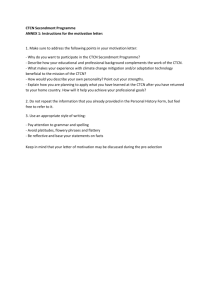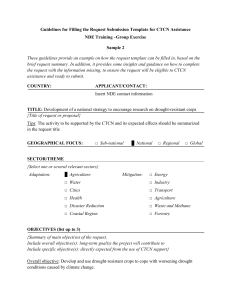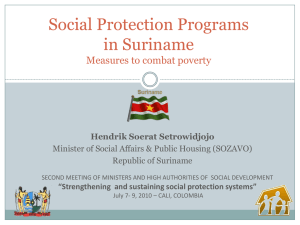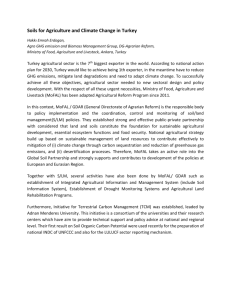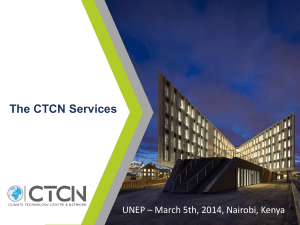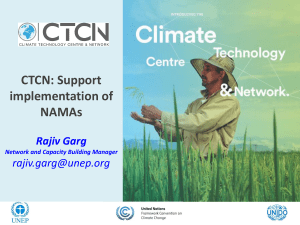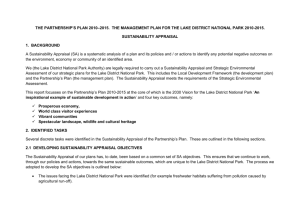15 Suggested Adaptation Request Reviewed
advertisement
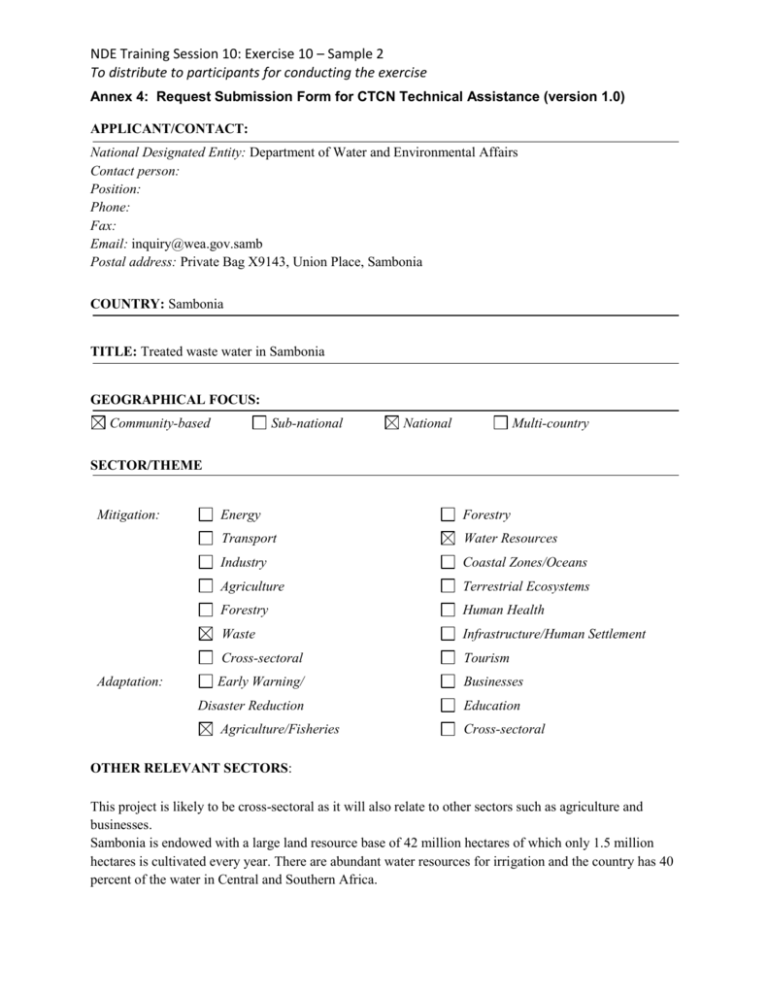
NDE Training Session 10: Exercise 10 – Sample 2 To distribute to participants for conducting the exercise Annex 4: Request Submission Form for CTCN Technical Assistance (version 1.0) APPLICANT/CONTACT: National Designated Entity: Department of Water and Environmental Affairs Contact person: Position: Phone: Fax: Email: inquiry@wea.gov.samb Postal address: Private Bag X9143, Union Place, Sambonia COUNTRY: Sambonia TITLE: Treated waste water in Sambonia GEOGRAPHICAL FOCUS: Community-based Sub-national National Multi-country SECTOR/THEME Mitigation: Adaptation: Energy Forestry Transport Water Resources Industry Coastal Zones/Oceans Agriculture Terrestrial Ecosystems Forestry Human Health Waste Infrastructure/Human Settlement Cross-sectoral Tourism Early Warning/ Businesses Disaster Reduction Education Agriculture/Fisheries Cross-sectoral OTHER RELEVANT SECTORS: This project is likely to be cross-sectoral as it will also relate to other sectors such as agriculture and businesses. Sambonia is endowed with a large land resource base of 42 million hectares of which only 1.5 million hectares is cultivated every year. There are abundant water resources for irrigation and the country has 40 percent of the water in Central and Southern Africa. NDE Training Session 10: Exercise 10 – Sample 2 To distribute to participants for conducting the exercise Agricultural output in Sambonia increased from 18 percent of the Gross Domestic Product (GDP) in 2008 to about 20 percent of GDP in 2009. This was as a result of increased area planted, good rainfall patterns in the whole country, as well as favorable agriculture policies by the government. The country recorded increased production of major crops during the 2009/10 agricultural season compared to the 2008/09 season, including; sunflower (118 percent increase), soya beans (50 percent increase), rice (39 percent increase), maize (31 percent increase), tobacco (7 percent increase) and wheat (5 percent increase). The agricultural sector continues to be the backbone of the Sambonian economy as it contributes to the growth of the economy and also to exports. Primary agriculture contribute about 35 percent to the country’s total non traditional exports (all the country’s exports other than copper and cobalt) and about 10 percent of the total export earnings for the country. PROBLEM STATEMENT Sambonia is a landlocked country in central Africa, with a tropical climate and consists mostly of high plateau, with some hills and mountains, dissected by river valleys. Sambonia is drained by two major river basins. The climate of Sambonia is tropical modified by elevation. In the Köppen climate classification, most of the country is classified as humid subtropical or tropical wet and dry, with small stretches of semi-arid steppe climate in the south-west and along the Zambezi valley. There are two main seasons, the rainy season (November to April) corresponding to summer, and the dry season (May/June to October/November), corresponding to winter. The dry season is subdivided into the cool dry season (May/June to August), and the hot dry season (September to October/November). The modifying influence of altitude gives the country pleasant subtropical weather rather than tropical conditions during the cool season of May to August However, average monthly temperatures remain above 20 °C (68 °F) over most of the country for eight or more months of the year. Politics in Sambonia take place in a framework of a presidential representative democratic republic, whereby the President of Sambonia is both head of state and head of government in a pluriform multi-party system. The government exercises executive power, while legislative power is vested in both the government and parliament. Sambonia became a republic immediately upon attaining independence in October 1971. Sambonia is divided into ten provinces, each administered by an appointed deputy minister. Each province is subdivided into several districts with a grand total of 57 districts. It is known that the un-regulated use of untreated waste water occurs within the agricultural sector and peri-urban to rural areas of the country and that these activities are intensified during periods of droughts and the imposition of water restrictions. Waste water is known to consist of a wide spectrum of pathogenic organisms that pose risks to human and ecosystem health. There is a concern that these unregulated practices of use will increase as water availability changes due to the projected changes in rainfall over the region. Thanks to CTCN support, nutrient loading of water bodies is likely to be reduced, which will have impacts on ecosystems health. Vulnerable communities who may rely on these water bodies may experience reduced health impacts, this is especially relevant for women who are generally tasked with water NDE Training Session 10: Exercise 10 – Sample 2 To distribute to participants for conducting the exercise collection and use this water for domestic purposes. The exposure of women and children to harmful pathogens in the water may also be reduced. A portion of government finances are ear-marked for the development of a full-scale plant for the treatment of waste water for reuse. Furthermore, a water officer was appointed in each of the main regions with the responsibility of oversight over the various local governments’ water management departments. As such there have been considerable advancements made in the approach to water management in the country, which creates a good foundation upon which to build. Through this process of transforming water management in the country working relationships between the different stakeholders have been established. DEVELOPMENT OF THE REQUEST The Department of Water and Environmental Affairs developed the Water Flagship Programme to address the current water challenges in the country and inform options for climate change adaptation. One of the key interventions that forms part of this flagship programme is the option of treating domestic and agricultural waste water to a standard that is suitable for use by agricultural customers. At present the country lacks the technical and institutional capacity to adequately introduce the use of treated waste water under this flagship programme. The Department of Water and Environmental Affairs decided that external assistance was needed to address these critical issues around capacity and provide assistance with pilot demonstrations which could then be scaled up to meet the water management goals of the country. A memorandum of agreement between government, SAM Development Bank and the Sambonian Agricultural Association was signed to co-finance pilot demonstrations and to jointly fund fullscale plants in the future. ASSISTANCE REQUESTED There is an urgent need to address the issue of waste water re-use through the development of policies to formalize the process of water re-use and invest in waste water infrastructure and technologies to ensure the safe treatment, distribution and storage of the treated water. Sambonia wishes to start using treated waste water in the agricultural sector not only to help to alleviate current water deficits but also to build resilience to future variability of water availability due to climate change. The country lacks the capacity to implement measures to facilitate these new waste water management objectives, and requires assistance with respect to an assessment and piloting of the most effective and feasible waste water treatment technologies based on their suitability to the local circumstances (government capacity, expert scientists and access to resources) and long-term sustainability of use. To begin the process of using treated waste water in industries and agriculture, the following key steps are required: Undertake a study on the feasibility of developing waste water treatment plants within the context of the existing water supply and waste water treatment infrastructure and state of the environment and human well-being. Purchase sample technologies for pilot demonstrations in order to test how the treatment technology will work and how the treated water will be stored and transferred to the intended user. NDE Training Session 10: Exercise 10 – Sample 2 To distribute to participants for conducting the exercise It is expected that this pilot, will entail the conventional treatment of waste water (in order to align with complementary national goals in terms of waste water treatment) and the use of different technologies to treat this recycled water so that it can be promoted for the reuse in the agricultural sector. To build capacity within the country on the use of the selected technology and processes piloted Develop capacity in the development, establishment and use of a monitoring and reporting system to facilitate the safe use of the treated waste water. Education of water users on the risks of using untreated waste water, the approaches to using treated waste water and benefits thereof. CTCN assistance will increased capacity of government officials in support of improved water management and enable them to identify the best technologies for the treatment, storage, transfer and use of treated waste water will be used. ALIGNMENT WITH NATIONAL PRIORITIES The country recognizes that the ultimate aim of water resource management is to achieve the sustainable use of water for the benefit of all users. This project also aligns with Sambonia’s climate change strategy that has identified the water sector as key sector requiring the implementation of adaptation strategies. The climate change strategy was finalized in 2012 and states that Sambonia is a water scarce country that will exceed the limits of its economically usable, land-based water resources by 2045. The strategy further highlights that the water sector is likely to be impacted due to climate change that will impact on the availability and distribution of rainfall and water resources throughout the year. The agricultural sector was identified in the strategy as the largest user of water (for irrigation) and is therefore a sector that is likely to be significantly impacted on by these projected changes to rainfall and water availability. PAST AND ONGOING EFFORTS In support of the implementation of the country’s Water Act, a national programme began in 2012 to address issues related to the supply of water and water management at all spheres of government. This has resulted in the government budgeting finances to invest in water treatment facilities and waste water treatment capacity: The Minister of Finance announced that the government would increase expenditure on water and waste infrastructure by 50%. These investments are intended to improve the equitable distribution of water in the country, safeguard public health, river health and ecological services and to minimize environmental disasters and treatment costs. EXPECTED BENEFITS The monitoring and reporting framework developed is used to monitor treated water and ensure that health and safety requirements are met. Farmers, and communities have an improved understanding of the risks of using un-treated waste water, reducing the un-regulated use of untreated waste water and thus to reduce the health impacts associated with its use. The expected assistance of the CTCN and related outcomes will be: NDE Training Session 10: Exercise 10 – Sample 2 To distribute to participants for conducting the exercise The provision of specialized knowledge by the CTCN on waste water infrastructure, expert knowledge on treatment technologies; cost-benefit analysis; networks to suppliers of preferred technologies is required to support: o o o o o o o The development of an understanding of the infrastructural requirements for treating, storing and supplying the treated waste water in Sambonia. Completion of a feasibility assessment undertaking this process and the potential risks to use for human health, if any will be produced. Specifically this would involve working with the team of national experts and researchers to best utilize their knowledge of the local circumstances to conduct a feasibility assessment. This will facilitate knowledge transfer, building networks with suppliers and establishing links to experts in the field who have had experience in this type of assessment (and the successful implementation thereof). An understanding of the available treatment technologies (best-practice) that can be applied to ensure that the water will be of a quality that is safe for humans and the environment. This information will be used to develop a fully-costed, preliminary design for the reclamation plant, and in conjunction with stakeholders and partners (government and private) implement a pilot demonstration plant. Monitoring and surveillance of the pilot demonstration plant which will provide testing of the system that could then be applied at full scale. Officials will have gained working knowledge in the monitoring and reporting system. Greater awareness of communities and farmers on the risks of using un-treated waste water and the benefits of using treated waste water will be achieved through outreach activities using training materials developed during this project for educational purposes. Stakeholder engagement to facilitate communication of the results will ensure uptake and involvement of different parties and increase potential for up-scaling. Government officials and partners will have received training and working knowledge in the monitoring and evaluation of the performance of the provision of treated waste water. KEY STAKEHOLDERS The Department of Water and Environmental Affairs, and the Director General in his capacity of National Water Officer, will have oversight for the execution of the project and responsibility for ensuring that these outcomes are best used to support the country’s goal to implement the use of treated waste water in the agricultural sector as contemplated in the Water Flagship Programme. Stakeholder National Department of Science and Technology Water for the people Local department of Water Affairs (pilot area) Agricultural Sector MONITORING AND EVALUATION Role in the response Oversight and management of the process based on existing policies and goals to be achieved. Training of officials where appropriate. Chair stakeholder engagement sessions (Lead organization). NDE Training Session 10: Exercise 10 – Sample 2 To distribute to participants for conducting the exercise By signing this request, I affirm that processes are in place in the country to monitor and evaluate the assistance provided by the CTCN. I understand that these processes will be explicitly identified in the Response Plan in collaboration with the CTC, and that they will be used in the country to monitor the implementation of the CTCN assistance. DATE AND SIGNATURE NDE: Date: Responsible Person: Signature: **PLEASE LIST ANY RELEVANT BACKGROUND DOCUMENTS AND PROVIDE THEIR WEB LINKS (IF WEB LINKS ARE NOT AVAILABLE PLEASE ATTACH THEM AS PDF FILES TO THE APPLICATION) Sambonia National Department of Environmental Affairs (2012). National Climate Change Response White Paper. Available at: https://www.environment.gov.sam/sites/default/files/docs/nationalstrategy_climatechange.pdf Sambonia National Department of Environmental Affairs (2010). Water sustainability status quo and challenges. Available at: https://www.environment.gov.sam/sites/default/files/docs/watersustainability_challenges.pdf. Sambonia National Department of Environmental Affairs (2010). Millennium Development Goals country report. Available at: https://www.environment.gov.sam/sites/default/files/docs/ MDGR_2010.pdf. THE COMPLETED FORM SHALL BE SENT TO THE CTCN@UNEP.ORG
